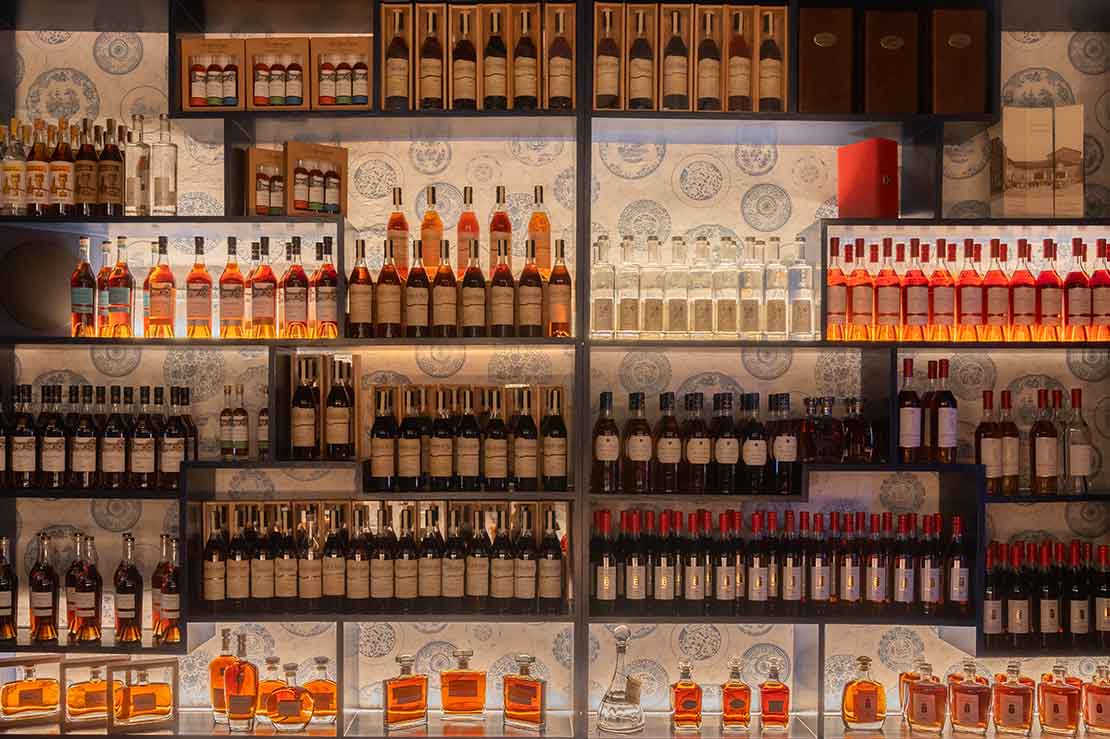Armagnac, the oldest spirit in France, has been gaining popularity in recent years among discerning drinkers in Asia. The oldest traceable record of the spirit, found in Prior Vital Dufour’s medical treatise published in 1310, boasts 40 virtues of drinking Armagnac in moderation – a marketing point still used by the Armagnac producers' association today.
Distilled from grapes, Armagnac is often confused with Cognac, its more well-known younger cousin to the north, which originated as brandy brought in by the Dutch in the 16th century. While Cognac established its boundaries in the Cognac region, Armagnac did so in Gascony.
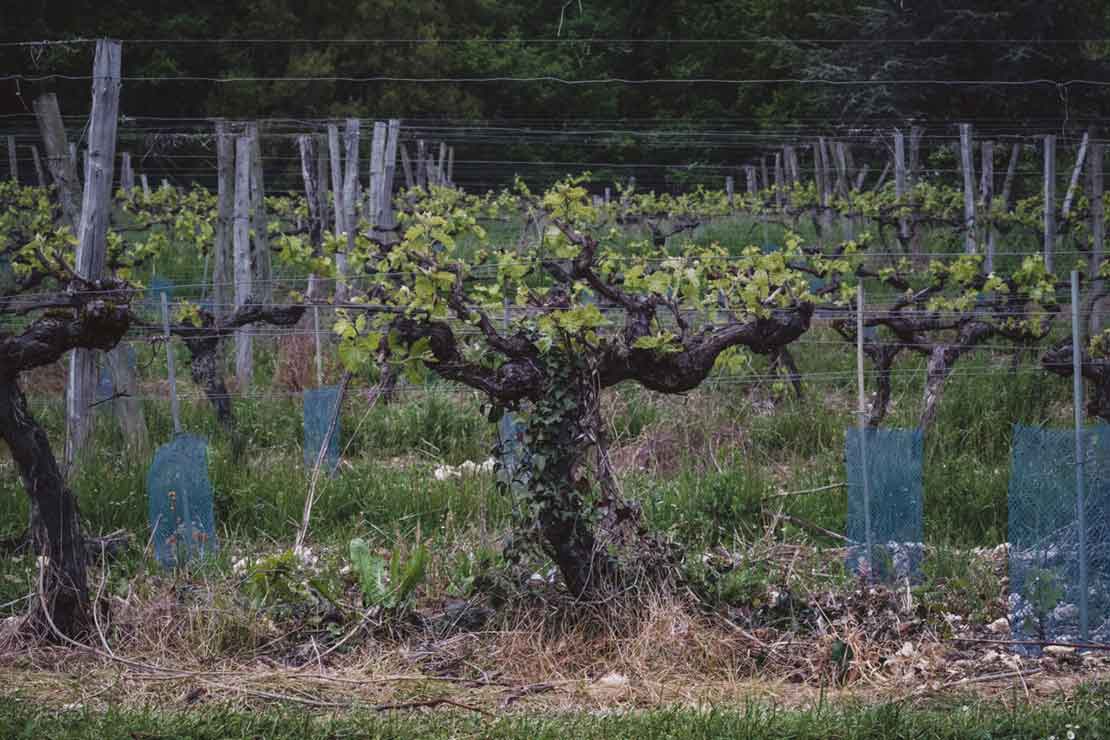
Other than Ugni Blanc, Armagnac can also be made using Folle Blanche, Baco 22A and other lesser known grape varietals. [Image source: Château d’Arton]
Ugni Blanc is used in Armagnac just as it is in Cognac, but Armagnac also includes Colombard, Folle Blanche, and Baco 22A – a hybrid grape approved for use in the production of Armagnac in 1938. Created by French grape breeder François Baco, Baco 22A is a cross between Folle Blanche and the American Noah grape, which is resistant to phylloxera. Other grape varietals like Jurançon Blanc, Clairette de Gascogne, Blanquette Grise, Plant de Graisse, Meslier Saint-François, and White Mauzac are also added, though rarely.
I had the pleasure of learning and tasting Armagnac in Singapore thanks to SyZyGy, a bar dedicated to the spirit, as well as Cognac and Calvados. Jeremie Tan, co-inspire the concept with owner Selin Tanetvitayavet, hosted a one-on-one session with me on a flight of five Armagnacs. Their characters were so different from one to another that, at times, I was wondering if I was tasting rum or whisky.
If you are familiar with Cognac, the spirit’s competitive advantage is its refined and smooth characteristics. The production focuses on creating a balanced taste profile. The double distillation in pot stills and aging in casks for a minimum of 2 years are the most apparent differences from Armagnac. The latter is distilled once in a column or Alambic still, and aging only requires a minimum of one year instead of two. Both use Limousin casks for aging, but those used for Cognac are more heavily charred for the vanillin and caramel characters. Additionally, the preferred Monlezun cask for Armagnac is less common now due to the diminishing forests in the Gascony region.
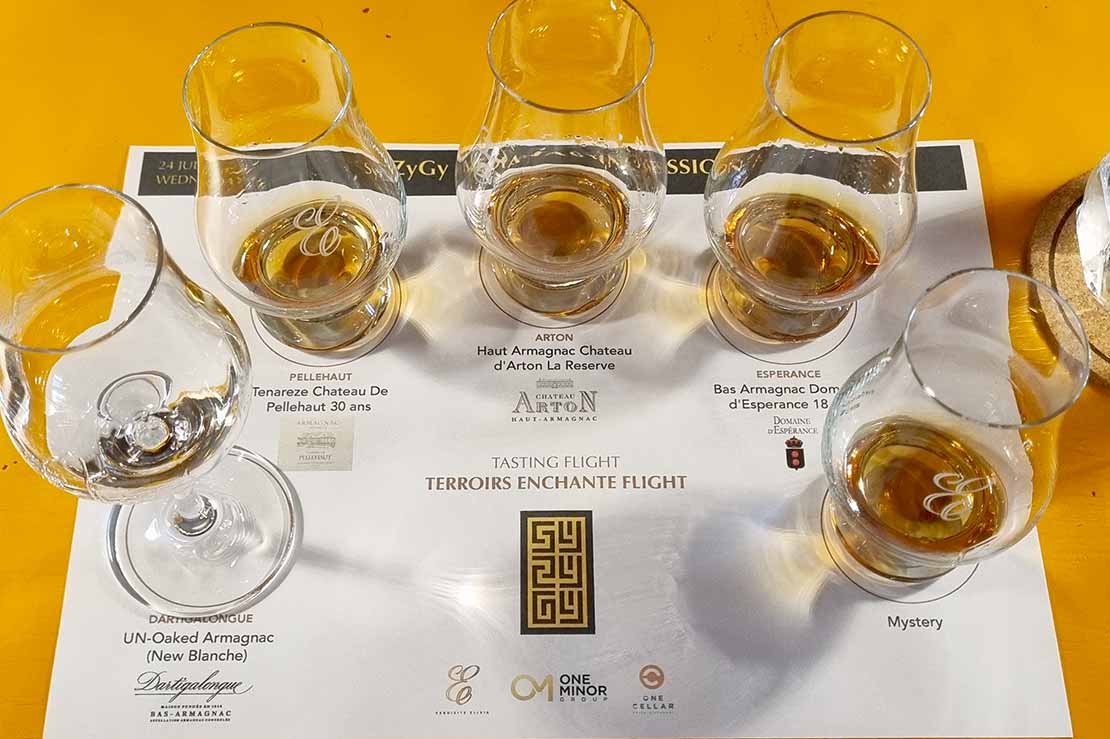
My tasting flight guided by Jeremie Tan at SyZyGy. [Photo: Kim Choong]
There are currently over 500 Armagnac producers in the three producing areas of Gascony: Bas Armagnac, Armagnac Ténarèze, and Haut Armagnac. Although there are twice as many Armagnac producers as Cognac houses, the volume of Armagnac exports is only 3% of Cognac’s total export of 223.8 million bottles annually (2021 statistics). Ninety percent of Cognac exports are dominated by the "big four" – Hennessy, Rémy Martin, Martell, and Courvoisier. Most Armagnac producers are small-scale operations, with family recipes passed down through generations, producing just enough to supply the local market. Marketing efforts are generally lacking, and some producers do not even have historically traceable backgrounds published on their websites for those interested in learning more.
New Regulations for Un-Oaked Armagnac
Starting in 2005, Armagnac producers have been allowed to bottle and sell “Blanche Armagnac,” a clear, unaged version of the spirit. The distillate can only be made with grapes harvested in a single year and of a single grape variety without aging. The newly made eau de vie is usually left to rest in inert containers like stainless steel or glass for at least 3 months rather than oak barrels. This preserves its fresh and fruity flavour, giving the spirit a more robust profile compared to the tradition-bound Cognac, which is only available in oak-aged formats. The new category of Armagnac is more widely accepted in cocktails and enjoyed neat, allowing producers to showcase their eau de vie and create a quicker new revenue stream.
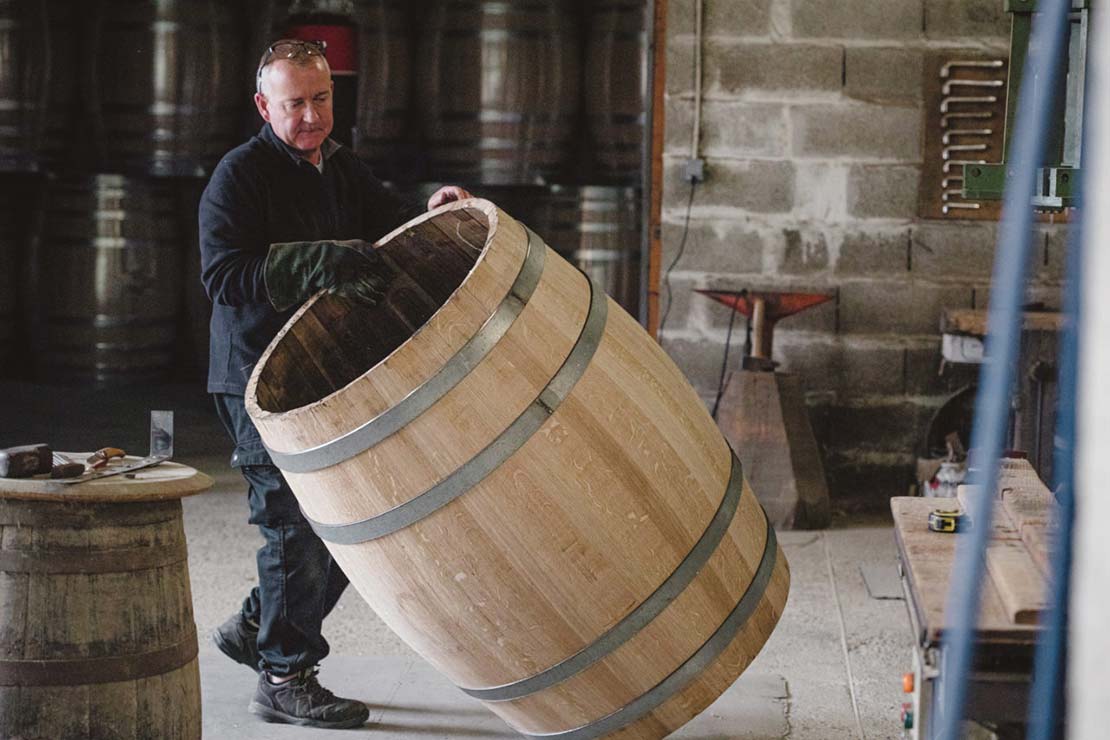
French oak used to age Armagnac are made by tonnelier, which translates to "cooper" in English, is a craft passed down through generations. Limousin oak is used like Cognac, but the “black oak”, Monlezun is popularly used for aging Armagnac.
Dartigalongue Un-oaked Armagnac (43.2%) is a Blanche, a blend of Baco, Ugni Blanc, and Folle Blanche from Bas-Armagnac with sandy-loamy soils. The 3-month-aged eau de vie had a surprisingly creamy texture, with nuttiness that came through subtly after the second sip, followed by fragrant fruity aromas of apple and pear. Dartigalongue Récolte 1993 (46.3%) on the other hand, is a single-year vintage Armagnac made from Folle Blanche harvested in 1993. This 30-year-old Armagnac is rich and elegant, with a chewy texture, notes of cigar leaves, and an incense aroma. It could easily be mistaken for a whisky.
Dartigalongue is currently run by its sixth generation. The family has been producing artisanal Armagnacs in Nogaro, Bas Armagnac, since 1838. Founded by Pascal Dartigalongue, the family’s traditions and expertise have been passed down through the generations while adapting to modern tastes and practices.
Wine Producers’ Armagnac
It’s common for Armagnac producers to also make wine, or vice versa. Château de Pellehaut in Ténarèze on the border of Bas-Armagnac has a 300-year history in Armagnac production. The Pellehaut estate practices sustainable farming and is among the first 300 farms to have obtained HVE (High Environmental Value) Level 3 certified by the French government.

Selling wines helps with keeping Armagnac production. Over the years, Château de Pellehaut has put its focus more on wine yet retaining their Armagnac quality. [Image source: Château de Pellehaut]
When the estate was passed down to brothers Martin and Mathieu Béraut, who are viticulturalists and oenologists, they started to focus more on their wines and beginning bottling them instead of selling them in bulk. Ultimately, achieving top five producers in Côtes de Gascogne, a region within Gascony famous for its aromatic and fruity white wine. Many of the same grapes are used to make wines as well as Armagnac.
Château de Pellehaut used to only use Ugni Blanc for their Armagnac until 1997, when they switched to using purely Folle Blanche. I tasted the Château de Pellehaut 30 Ans (40%), which was still the 100% Ugni Blanc vintage. It was aged in a coarse-grain French oak that has a higher and faster extraction of wood flavour compared to finer-grain oak. The 30 years’ liquid could have been mistaken for a Cognac with its vanillin and nuttiness, yet with some contrasting funk on the nose.
From the same region is Domaine d’Espérance, a young producer with an old estate bought by Jean-Louis and Claire de Montesquiou in 1990. Their wine is served in Air France’s first-class cabin, and their range of Armagnac is included in the Scotch Malt Whisky Society’s offerings.
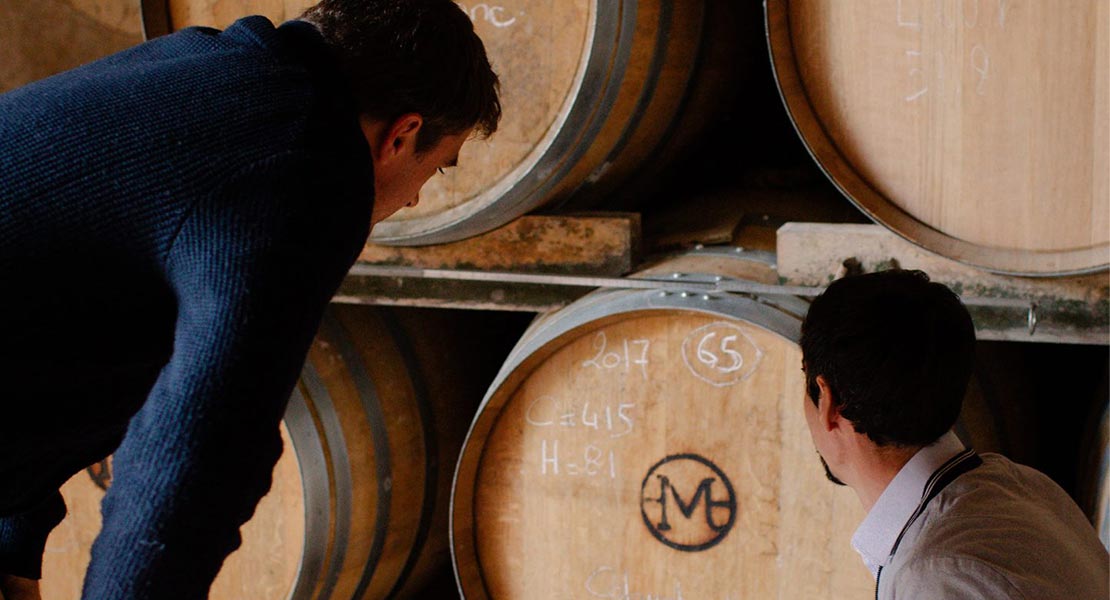
Château Arton is open to visitors of their vineyard and cellar. [Image source: Château Arton]
The Domaine d’Espérance 18 Ans (47%) is a blend of different vintages from different barrels with no added water or colouring. The Baco and Folle-Blanche eau de vie were distilled in 2001 or earlier and were each kept in their original casks until the time of blending. Compared to the Pellehaut’s 30-year-old, this Armagnac’s taste skewed more towards whisky, with rich dried fruit notes, medium dark chocolate, and a peppery finish.
The Rarest Armagnac Terroir
Out of the three areas, Haut-Armagnac is the rarest, containing only 5% of the total production of Armagnac. The terroir diminished due to phylloxera and hasn’t been able to recover since. Its unique soil type, peyrusquet, consists mainly of clay and limestone, giving a mineral characteristic to the grapes.
A notable producer from the region is Château d’Arton, which produces single-estate Armagnac that reflects the terroir of their vineyards. The estate was closed down for a period of time and later revived in the 1970s by Patrick de Montal and his wife, Victoire de Montesquiou, a descendant of Charles de Batz de Castelmore, who’s known as the real-life d’Artagnan. Alexandre Dumas based The Three Musketeers on d’Artagnan, a legacy the château now embraces.
A winery first, Château d’Arton also produces brandies and liqueurs from fruits harvested in their own orchard, practising sustainable viticulture to maintain the health of their vineyard and the surrounding environment. Their award-winning La Réserve d'Arton (45%) is an Armagnac distilled from the estate’s dry white wine, a blend of 6-year-old and older Colombard and Ugni Blanc that reflects the unique estate’s terroir. On the nose, it smelled like chamomile tea, but then a complex taste of citrus on the palate knocked you off balance and picked you up again with a delicate, dusty finish.
Cask Focus and Independent Bottling
Bordeneuve was founded by Jean-Claude Guasch, an Armagnac cask collector and broker in Gascony. The focus of the estate is the long aging of Armagnac in casks of exceptional quality, only produced in France. Their vineyard of Ugni Blanc, Colombard, and Baco are the grapes used for Armagnac. Based in Cravancères in the Bas-Armagnac region, the producer bottles their Armagnac at cask strength to highlight the characters from the oak.
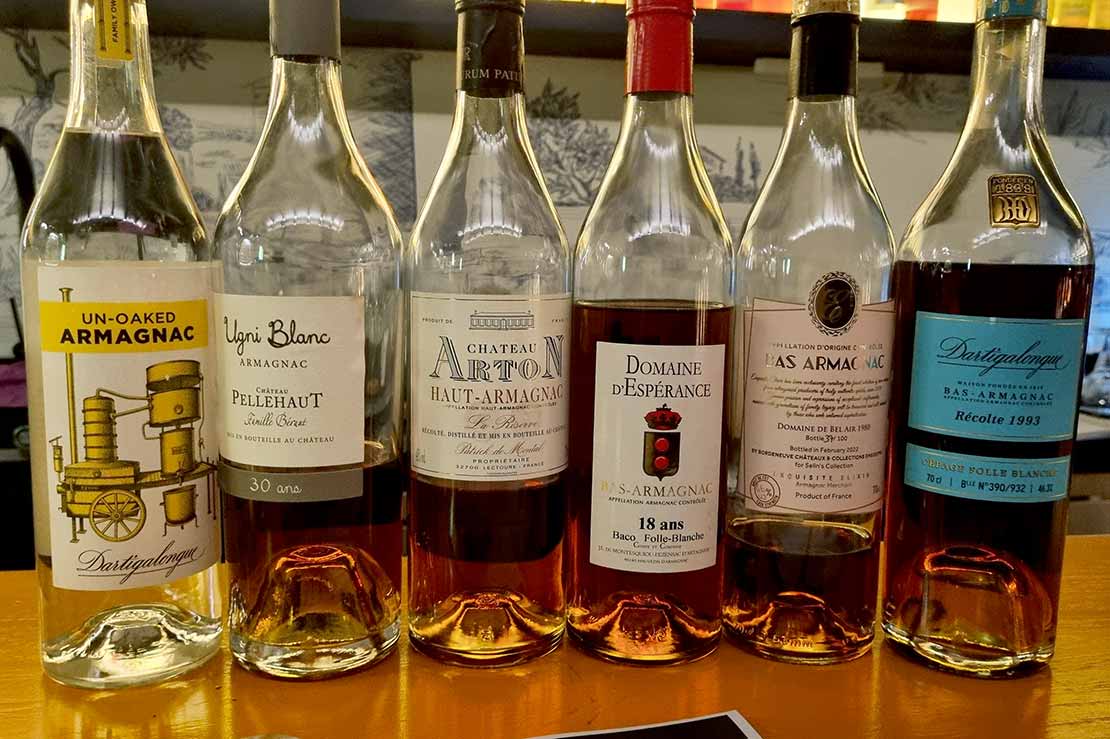
From left: Dartigalongue Un-oaked Armagnac, Château de Pellehaut Ugni Blanc 30 ans, Château Arton Haut-Armagnac La Réserve d'Arton, Domaine d’Espérance 18 Ans, Domaine de Bel Air 1980 and Dartigalongue Récolte 1993. [Photo: Kim Choong]
The last dram I tasted was the Domaine de Bel Air 1980 (46%), a cask selected by Selin and bottled by Bordeneuve, who also imports all of these Armagnacs. The 100-bottle Armagnac consists of 60% Baco and 40% Ugni Blanc. It is deep amber in colour with an aromatic yet oaky note on the nose, dark chocolate and dried apricot on the palate, and a dry finish that leaves you chasing for the next sip.
Every Armagnac I tasted in that session was unique. What was so incredible about going into the session without any expectations was that I came out knowing more about one subject, yet realizing how little I still knew.
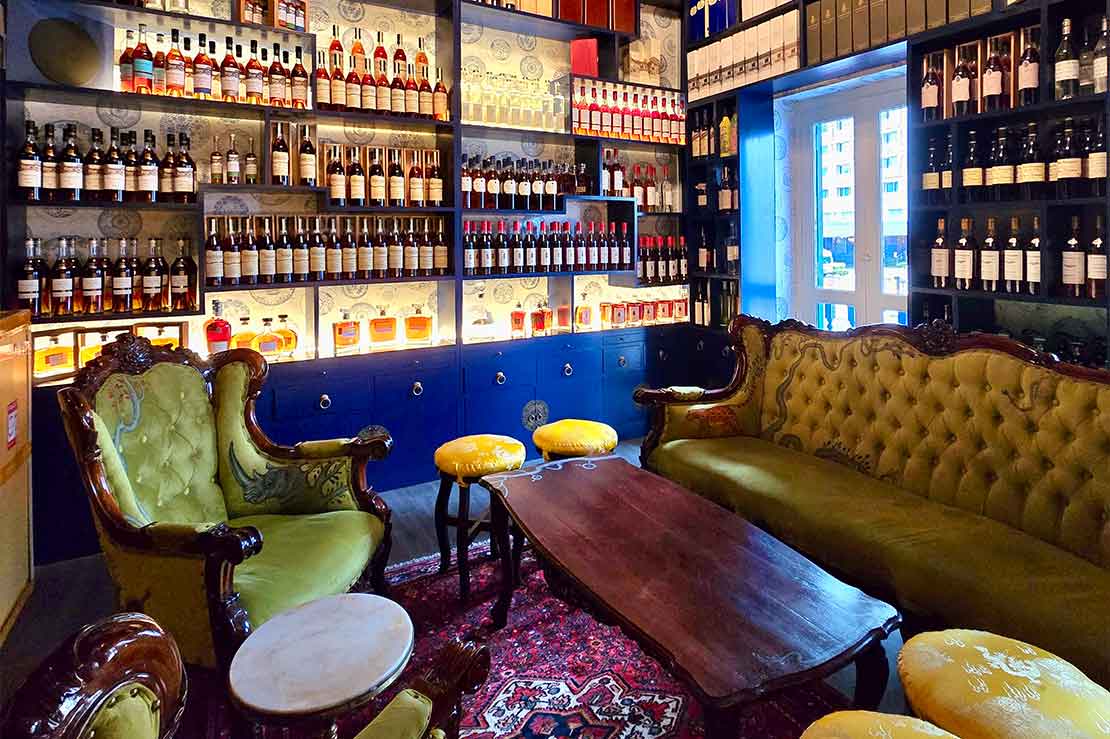
SyZyGy, the first bar dedicated to Armagnac, Cognac and Calvados. [Image source: SyZyGy Singapore]
SyZyGy offers tasting flights of a variety of three to four 15ml pours of Armagnacs, ranging from S$30 to S$180. There are some rare bottles as well, served by the dram, like the Laberdolive 1923, bottled in 2021 after being aged for 102 years in French black oak. Cocktails and charcuterie boards are also available.
- T -
